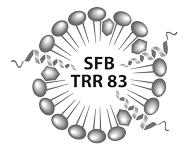Sonderforschungsbereich / Transregio (Collaborative Research Centre) 83
International SFB/Transregio 83 Symposium
Molecular Architecture and Cellular Functions of Lipid/Protein Assemblies
May 19 - 20, 2022, Heidelberg
Biological membranes with their two key constituents - proteins and lipids - mediate an astonishing array of functions ranging from simple barriers to complex signal transduction platforms. In contrast to an aqueous solution, where protein interactions are controlled by a single solvent - water -, lipid bilayers contain hundreds of different acyl chains and head groups providing distinct amphipathic interfaces and thus open another dimension to create architectural and functional diversity. The central aims of the TRR 83 are to characterize the molecular composition and structural organization of distinct membrane domains, to elucidate their physical and chemical properties and to understand their physiological functions. The TRR 83 joins scientists from three locations – Bonn, Dresden, and Heidelberg – and has significantly advanced the current status in lipid analysis, lipid imaging, and lipid cross-linking by developing various new chemical tools. For example, TRR 83 members have synthesized novel functionalized lipids, which led to the identification and characterization of the highly specific interaction of a single sphingolipid species with a vesicular membrane protein. These and other functionalized lipids are now used by many researchers world-wide. Similarly, the lipidomics platforms have made significant progress in the analysis of critical, but hard to detect lipid species, and have established comprehensive and quantitative lipid analysis ranging from distinct protein/lipid assemblies to entire organisms. The TRR 83 joins experts in fields as different as e.g. synthetic organic chemistry, biochemistry, cell biology, virology, and immunology (as well as many others) and provides them with the opportunity to address challenging questions, which could not be solved by individual approaches. Using new functionalized analogues of single lipid species that can be introduced into living cells, their fates and functions can be determined by physicochemical and imaging methods. Together with continuously developing analytical mass spectrometric approaches these tools are used to elucidate a contribution of specific lipid environments to the translocation of proteins across membranes, to the intracellular formation of virus particles, lipid droplets, and endosomes, and to understand the complex events that allow the controlled fusion of membranes, as e.g. in neurotransmission. Analyses in tissue culture and in whole organisms are complemented by in vitro reconstitution of functional membrane protein complexes from completely defined lipids and proteins. Combining these approaches will eventually allow to unequivocally attribute specific functions to individual components of such lipid/protein assemblies.



